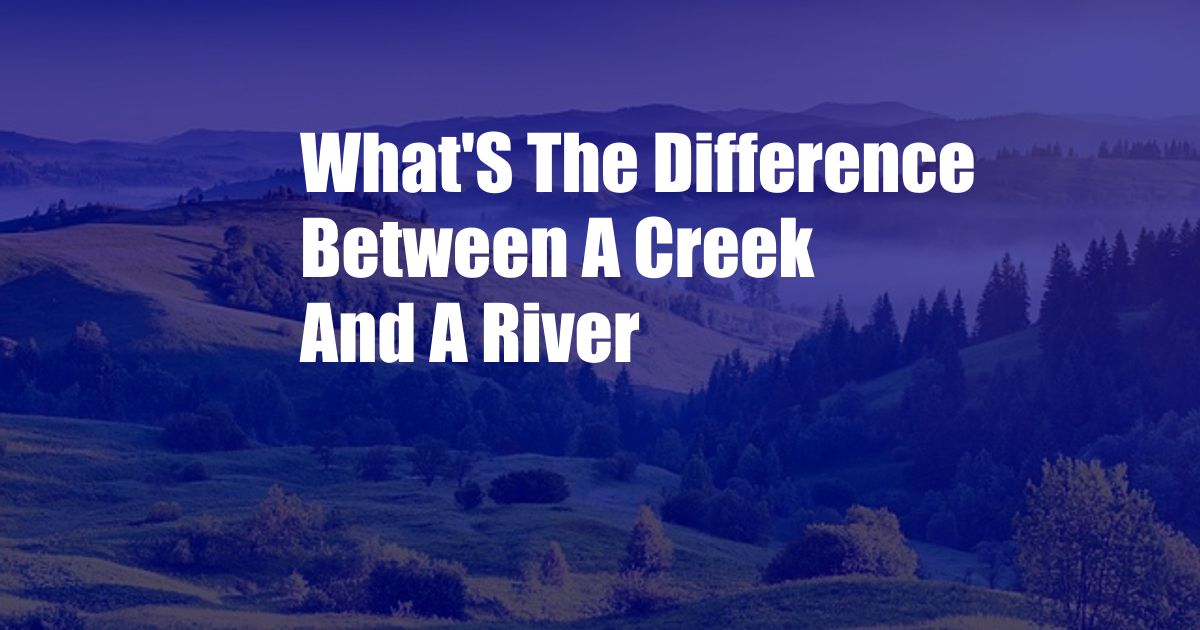
What’s the Difference Between a Creek and a River?
As I navigated the winding trail, the gentle murmur of water carried by the wind reached my ears. Curiosity piqued, I ventured closer, only to be greeted by two distinct waterways. One, a narrow stream with clear, shallow waters, babbled over rocks and pebbles. The other, grander in scale, flowed steadily with a deep, murky current. A question arose: what was the difference between these two aquatic wonders?
In this article, we delve into the fascinating world of flowing waterways and explore the key distinctions between creeks and rivers, their characteristics, and their significance in the natural ecosystem.
Understanding Creeks and Rivers
Creeks, also known as brooks or streams, are relatively small, narrow waterways. They typically originate from springs or seeps and flow downhill, often meandering through forests or meadows. Creeks are characterized by their clear, shallow waters that ripple over rocks and gravel beds. Due to their smaller size, creeks experience rapid fluctuations in water levels during rainfall events and may even dry up during periods of drought.
Rivers, on the other hand, are much larger and more voluminous than creeks. They are formed by the convergence of multiple creeks and streams and can extend for hundreds or even thousands of miles. Rivers exhibit a deep, powerful current and carry a significant amount of sediment and nutrients downstream. Riverbanks are often lined with lush vegetation, creating vibrant riparian ecosystems that support a diverse array of plant and animal life.
Key Differences between Creeks and Rivers
- Size and Flow Rate: Creeks are smaller and narrower than rivers, with a lower flow rate. Rivers, in contrast, are larger, wider, and have a more powerful current.
- Depth: Creeks are generally shallow, allowing sunlight to reach the bottom and support aquatic plants. Rivers, on the other hand, are deeper, with limited light penetration.
- Water Clarity: Creeks often have clear water due to their smaller size and faster-flowing currents that prevent sediment from accumulating. Rivers, however, tend to have murkier water due to the increased sediment load and slower flow rates.
- Bank Morphology: Creek banks are often steep and rocky, reflecting the erosive power of the water. Riverbanks, conversely, are typically more gently sloping and vegetated, providing habitat for a variety of riparian species.
- Ecological Significance: Both creeks and rivers play vital roles in the ecosystem. Creeks provide crucial habitat for aquatic insects and amphibians, and serve as important breeding grounds for fish. Rivers, due to their larger size and flow rates, support a wider range of aquatic life and influence the surrounding riparian ecosystems.
Expert Advice for Navigating Creeks and Rivers
“When exploring creeks and rivers, it’s essential to prioritize safety,” says seasoned outdoor enthusiast, Emily Carter. “Wear appropriate footwear and clothing, and always be aware of the current and water depth. Never attempt to cross rapidly flowing or deep water without proper safety equipment and knowledge.”
Another expert, river guide Mark Johnson, emphasizes the importance of respecting these waterways. “Creeks and rivers are fragile ecosystems that support a diverse array of life. Avoid littering, disturbing wildlife, or altering the natural flow of the water. By respecting these natural wonders, we ensure their preservation for future generations.”
Conclusion
The distinction between creeks and rivers lies not only in their physical characteristics but also in their ecological significance and the role they play in shaping the landscape. Whether it’s the gentle murmur of a creek or the mighty flow of a river, each waterway holds its own charm and contributes to the beauty and diversity of our planet. By understanding the differences between creeks and rivers, we can better appreciate their value and work towards conserving these vital ecosystems.
So, the next time you find yourself by a flowing body of water, pause and observe. Is it a creek, with its clear waters and babbling brook? Or is it a river, carrying the weight of a thousand streams? Embark on a journey of discovery and unravel the secrets of these captivating waterways.